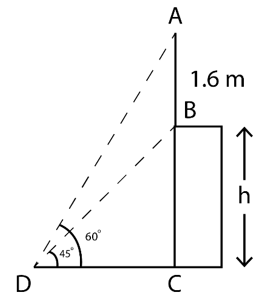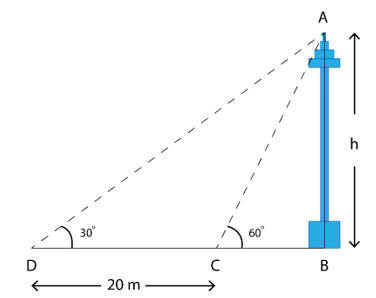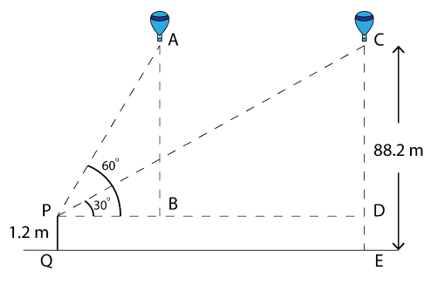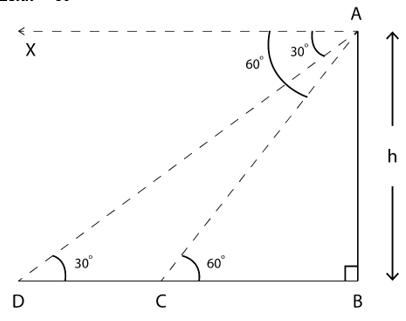NCERT Solutions for Class 10 Maths Chapter 9 Exercise 9.1 Some Applications of Trigonometry
NCERT Solutions for Class 10 Maths Chapter 9 Exercise 9.1 Some Applications of Trignometry. Ex 9.1 class 10 contains 16 questions, for which detailed answers have been provided in this note. In case you are looking at studying the remaining Exercise for Class 10 for Maths NCERT solutions for other Chapters, you can click the link at the end of this Note.
| Category | NCERT Solutions for Class 10 |
| Subject | Maths |
| Chapter | Chapter 9 |
| Exercise | Exercise 9.1 |
| Chapter Name | Some Applications of Trigonometry |
NCERT Solutions for Class 10 Maths Chapter 9 Exercise 9.1 Some Applications of Trigonometry
1. A circus artist is climbing a 20 m long rope, which is tightly stretched and tied from the top of a vertical pole to the ground. Find the height of the pole, if the angle made by the rope with the ground level is 30°.
Let the height of the pole AB be h.

In ΔABC, ∠B = 90°
sin 30° = =
=
h = 10 m
Hence, the height of the pole is 10m.
2. A tree breaks due to storm and the broken part bends so that the top of the tree touches the ground making an angle 30° with it. The distance between the foot of the tree to the point where the top touches the ground is 8 m. Find the height of the tree.
- Let the tree AC’ broke at point A and the broken part AC’ bends over such that it touches the ground at C

AC’ = AC
In ΔABC, ∠B = 90°
tan 30° =
m
Similarly, cos 30° =
m
Height of the tree = BA + AC’ = BA + AC
= +
m
=
= 8√3m
Hence, the height of the tree is 8√3m
Class 10 Maths Chapter 9 Exercise 9.1 Solutions
3. A contractor plans to install two slides for the children to play in a park. For the children below the age of 5 years, she prefers to have a slide whose top is at a height of 1.5 m, and is inclined at an angle of 30° to the ground, whereas for elder children, she wants to have a steep slide at a height of 3 m, and inclined at an angle of 60° to the ground. What should be the length of slide in each case?
- Let a slide has its top at a height of h meters and is inclined at an angle θ to the ground. Let l denote the length of slide

In ΔABC, ∠B = 90°
sin θ = =
For children below age of 5 years, h = 1.5 m, θ = 30°
For elder children, h = 3 m, θ = 60°
= 2√3m
4. The angle of elevation of the top of a tower from a point on the ground, which is 30 m away from the foot of the tower, is 30°. Find the height of the tower.
- Consider the tower AB and the point C on the ground, 30 m away from the foot B of the tower. Let the height of the tower be h

In ΔABC, ∠B = 90°
tan 30° =
Hence, the height of the tower is 10√3 m.
5. A kite is flying at a height of 60 m above the ground. The string attached to the kite is temporarily tied to a point on the ground. The inclination of the string with the ground is 60°. Find the length of the string, assuming that there is no slack in the string.
- Consider the kite flying at point A and the string held on the ground at point C. Let the length of the string be l

In ΔABC, ∠B = 90°
sin 60° =
Hence, the length of the string is 40√3 m.
Class 10 Maths Ex 9.1 NCERT Solutions
6. A 1.5 m tall boy is standing at some distance from a 30 m tall building. The angle of elevation from his eyes on the top of the building increases from 30° to 60° as he walks towards the building. Find the distance he walked towards the building.
- Consider the AC, B is the point in line of sight of the boy. Then, he moves from PQ to RS
∴ PQ = RS = BC = 1.5m
AB = AC – BC = 30 – 1.5 = 28.5m

In ΔAPB, ∠B = 90°
tan 30° =
BP = AB√3
In ΔABR, ∠B = 90°
tan 60° =
√3 =
BR =
Distance travelled by boy = BP – BR
= AB√3 –
= 19√3 m
7. From a point on the ground, the angles of elevation of the bottom and the top of a transmission tower fixed at the top of a 20 m high building are 45° and 60° Find the height of the tower.
- Consider the tower AB mounted on the top of the building BC and the point D on the ground

In ΔBCD, ∠C = 90°
tan 45° =
1 =
∴ DC = 20m
In ΔACD, ∠C = 90°
tan 60° =
√3 =
AC = 20√3m
Height of the tower = AC – BC
= 20√3 – 20m
= 20(√3 – 1)m
8. A statue, 1.6 m tall, stands on the top of a pedestal. From a point on the ground, the angle of elevation of the top of the statue is 60°and from the same point the angle of elevation of the top of the pedestal is 45°. Find the height of the pedestal.
- Let AB be the statue, mounted on the pedestal BC of height h

In ΔBCD, ∠C = 90°
tan 45° =
1 =
∴ DC = h
In ΔACD, ∠C = 90°
tan 60° =
√3 =
Putting DC = h
√3 =
√3h = 1.6 + h
h=
h=
h=
h = 0.8(√3 + 1) m
NCERT Solutions Class 10 Maths Ex 9.1
10. The angle of elevation of the top of a building from the foot of the tower is 30° and the angle of elevation of the top of the tower from the foot of the building is 60°. If the tower is 50 m high, find the height of the building.
- Let AB be a building of height h and CD be the tower of height 50 m

In ΔCDB, ∠D = 90°
tan 60° =
√3 =
DB=
In ΔADB, ∠B = 90°
tan 30° =
Putting, DB=
h =
10. Two poles of equal height are standing opposite each other on either side of the road, which is 80 m wide. From a point between them on the road, the angles of elevation of the top of the poles are 60° and 30°, respectively. Find the height of the poles and the distances of the point from the poles.
- Consider poles to be AB and CD of height h. Point P is located on the road as shown

In ΔCDP, ∠D = 90°
tan 30° =
DP = h√3
In ΔABP, ∠B = 90°
tan 60° =
√3 =
Width of the road = DB = DP + BP
∴80 = h√3 +
80 =
80 =
h = 20√3 m
DP = h√3 = 60 m
BP = = 20m
The height of the poles is 20√3 and the point P is at a distance of 60 m from one pole and 20 m from the other.
11. A TV tower stands vertically on a bank of a canal. From a point on the other bank directly opposite the tower, the angle of elevation of the top of the tower if 60°. From another point 20 m away from this point on the line joining this point to the foot of the tower, the angle of elevation of the top of the tower is 30°. Find the height of the tower and width of the canal.
- Consider the tower AB, C is the point on the opposite bank of the canal and the point D be as indicated. Let the height of the tower be h

In ΔABD, ∠B = 90°
tan 30° =
DB = h√3
In ΔABC, ∠B = 90°
tan 60° =
√3 =
Distance between D and C = DB – CB
∴20 = h√3 –
20 =
20 =
h = 10√3 m
Width of the canal = CB = = 10 m
12. From the top of a 7 m high building, the angle of elevation of the top of a cable tower is 60° and the angle of depression of its foot is 45°. Determine the height of the tower.
- Let the building be AB. The point P lies on the tower CD in the same horizontal line as the top A of the building
∴PD = AB = 7m

In ΔAPD, ∠P = 90°
tan 45° =
1 =
AP = 7m
In ΔACP, ∠P = 90°
tan 60° =
√3 =
CP = 7√3 m
Height of the tower = CP + PD = 7 + 7√3 = 7(√3+1)m
13. As observed from the top of a 75 m high lighthouse from the sea-level, the angles of depression of two ships are 30° and 45°. If one ship is exactly behind the other on the same side of the lighthouse, find the distance between the two ships.
- Consider the lighthouse AB of height 75 m. AX be the horizontal. D and C are the positions of two ships.
∴AX // DB
∴∠ADB = ∠DAX = 30° (Alternate angles)
∠ACB = ∠CAX = 45°

In ΔABD, ∠B = 90°
tan 30° =
BD = 75√3 m
In ΔABC, ∠B = 90°
tan 45° =
1 =
BC = 75 m
Distance between the two ships = BD – BC
= 75√3 – 75
= 75(√3-1)m
Ex 9.1 Class 10 Maths NCERT Solutions
14. A 1.2 m tall girl spots a balloon moving with the wind in a horizontal line at a height of 88.2 m from the ground. The angle of elevation of the balloon from the eyes of the girl at any instant is 60°. After some time, the angle of elevation reduces to 30°. Find the distance traveled by the balloon during the interval.
- Let the girl be denoted by PQ. A and C are the initial and final positions of balloon, respectively. PBD is a horizontal line where B and D lie directly below A and C. E is a point on the ground below C
PQ = DE = 1.2 m
AB = CD = CE – DE = 88.2 – 1.2 = 87 m

In ΔPCD, ∠D = 90°
tan 30° =
tan 30° =
PD = 87√3 m
In ΔABP, ∠B = 90°
tan 60° =
√3 = [AB = CD = 87m]
Distance travelled by the balloon = AC = BD = PD – PB
= 87√3 –
=
=
= 58√3 m
15. A straight highway leads to the foot of a tower. A man standing at the top of the tower observes a car at an angle of depression of 30°, which is approaching the foot of the tower with a uniform speed. Six seconds later, the angle of depression of the car is found to be 60°. Find the time taken by the car to reach the foot of the tower from this point.
- Consider the tower AB of height h. AX be the horizontal. D is the initial position and C is the position of the car after six seconds.
∴AX // DB
∴∠ADB = ∠DAX = 30° (Alternate angles)
∠ACB = ∠CAX = 60°

In ΔABD, ∠B = 90°
tan 30° =
BD = h√3 m
In ΔABC, ∠B = 90°
tan 60° =
√3 =
Distance between D and C = DB – CB
= h√3 –
=
=
Speed of the car = =
=
Time taken to travel remaining (BC = ) distance =
=
= 3 s
16. The angles of elevation of the top of a tower from two points at a distance of 4 m and 9 m from the base of the tower and in the same straight line with it are complementary. Prove that the height of the tower is 6 m.
- Let the height of the tower AB be h. Point C and D are away from the foot of the tower. Let the angle of elevation of the top of the tower from D be α and from C be β and are complementary
∴α and β and are complementary
α + β = 90°

In ΔABD, ∠B= 90°
tan α = =
………(i)
In ΔABC, ∠B= 90°
tan β = =
tan (90° – α) = (∴ α + β = 90°)
cot α = (∴ tan (90° – θ) = cotθ)
=
Putting value from equation (i)
=
h² = 36
h = ±6m
Height cannot be negative
Hence, the height of the tower is 6m.
NCERT Solutions for Class 10 Maths Chapter 9 Exercise 9.1 – Some Applications of Trignometry, has been designed by the NCERT to test the knowledge of the student on the topic – Heights and Distances
